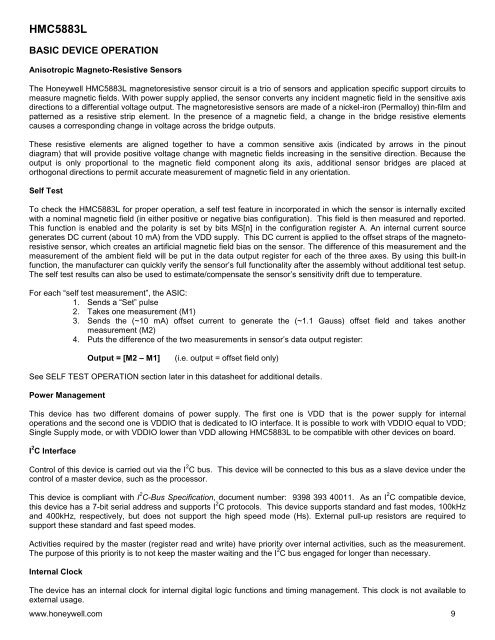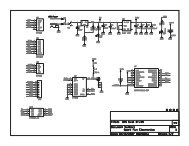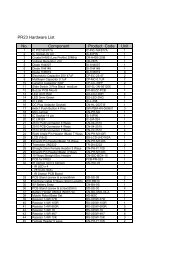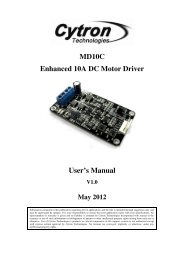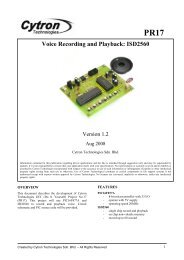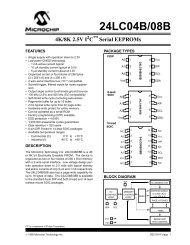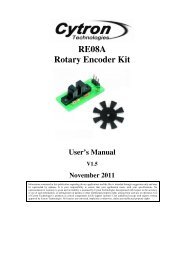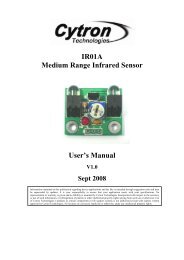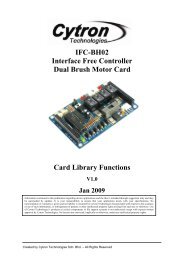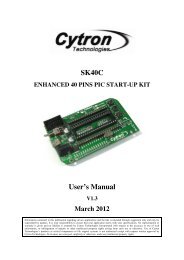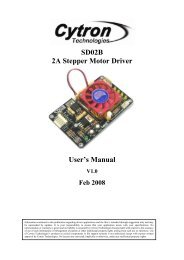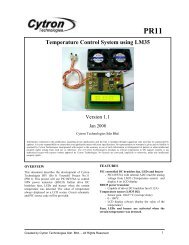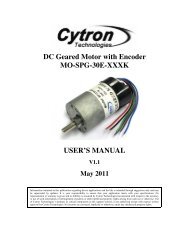Three-Axis Digital Compass IC HMC5883L
Three-Axis Digital Compass IC HMC5883L
Three-Axis Digital Compass IC HMC5883L
You also want an ePaper? Increase the reach of your titles
YUMPU automatically turns print PDFs into web optimized ePapers that Google loves.
<strong>HMC5883L</strong><br />
BAS<strong>IC</strong> DEV<strong>IC</strong>E OPERATION<br />
Anisotropic Magneto-Resistive Sensors<br />
The Honeywell <strong>HMC5883L</strong> magnetoresistive sensor circuit is a trio of sensors and application specific support circuits to<br />
measure magnetic fields. With power supply applied, the sensor converts any incident magnetic field in the sensitive axis<br />
directions to a differential voltage output. The magnetoresistive sensors are made of a nickel-iron (Permalloy) thin-film and<br />
patterned as a resistive strip element. In the presence of a magnetic field, a change in the bridge resistive elements<br />
causes a corresponding change in voltage across the bridge outputs.<br />
These resistive elements are aligned together to have a common sensitive axis (indicated by arrows in the pinout<br />
diagram) that will provide positive voltage change with magnetic fields increasing in the sensitive direction. Because the<br />
output is only proportional to the magnetic field component along its axis, additional sensor bridges are placed at<br />
orthogonal directions to permit accurate measurement of magnetic field in any orientation.<br />
Self Test<br />
To check the <strong>HMC5883L</strong> for proper operation, a self test feature in incorporated in which the sensor is internally excited<br />
with a nominal magnetic field (in either positive or negative bias configuration). This field is then measured and reported.<br />
This function is enabled and the polarity is set by bits MS[n] in the configuration register A. An internal current source<br />
generates DC current (about 10 mA) from the VDD supply. This DC current is applied to the offset straps of the magnetoresistive<br />
sensor, which creates an artificial magnetic field bias on the sensor. The difference of this measurement and the<br />
measurement of the ambient field will be put in the data output register for each of the three axes. By using this built-in<br />
function, the manufacturer can quickly verify the sensor’s full functionality after the assembly without additional test setup.<br />
The self test results can also be used to estimate/compensate the sensor’s sensitivity drift due to temperature.<br />
For each “self test measurement”, the AS<strong>IC</strong>:<br />
1. Sends a “Set” pulse<br />
2. Takes one measurement (M1)<br />
3. Sends the (~10 mA) offset current to generate the (~1.1 Gauss) offset field and takes another<br />
measurement (M2)<br />
4. Puts the difference of the two measurements in sensor’s data output register:<br />
Output = [M2 – M1]<br />
(i.e. output = offset field only)<br />
See SELF TEST OPERATION section later in this datasheet for additional details.<br />
Power Management<br />
This device has two different domains of power supply. The first one is VDD that is the power supply for internal<br />
operations and the second one is VDDIO that is dedicated to IO interface. It is possible to work with VDDIO equal to VDD;<br />
Single Supply mode, or with VDDIO lower than VDD allowing <strong>HMC5883L</strong> to be compatible with other devices on board.<br />
I 2 C Interface<br />
Control of this device is carried out via the I 2 C bus. This device will be connected to this bus as a slave device under the<br />
control of a master device, such as the processor.<br />
This device is compliant with I 2 C-Bus Specification, document number: 9398 393 40011. As an I 2 C compatible device,<br />
this device has a 7-bit serial address and supports I 2 C protocols. This device supports standard and fast modes, 100kHz<br />
and 400kHz, respectively, but does not support the high speed mode (Hs). External pull-up resistors are required to<br />
support these standard and fast speed modes.<br />
Activities required by the master (register read and write) have priority over internal activities, such as the measurement.<br />
The purpose of this priority is to not keep the master waiting and the I 2 C bus engaged for longer than necessary.<br />
Internal Clock<br />
The device has an internal clock for internal digital logic functions and timing management. This clock is not available to<br />
external usage.<br />
www.honeywell.com 9


